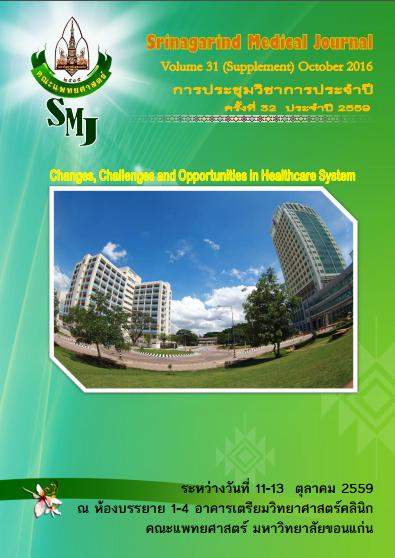Difference of Bone Mineral Density between Postmenopausal Women with and Without Metabolic Syndrome
Keywords:
postmenopausal women, metabolic syndrome, bone mineral densityAbstract
Background and Objective: Metabolic syndrome (MS) is a cluster of diseases including abdominal obesity, lipid abnormalities, hypertension, and hyperglycemia. It is associated with systemic inflammatory response which may affect bone structure or bone metabolism. This study aims to the cross-sectional study aimed to compare bone mineral density (BMD) of postmenopausal women (PMW) with metabolic syndrome (MS) and without MS and evaluate the association of the MS components and BMD.
Methods: PMW aged between 45 to 65 years old, from health check-up program or who treating metabolic syndrome in Srinagarind Hospital, Khon Kaen University between May 2015 and February 2016 were enrolled. MS diagnosed according to NCEP ATP III 2005 criteria. BMD was measured at lumbar spine, femoral neck and total hip by dual energy X-ray absorptiometry.
Results: Of the 125 PMW with MS and 125 PMW without MS were enrolled. Mean age±SD was 57.9±4.2 and 56.6±4.1 years, years since menopause was 7.6 ± 4.7 and 6.4 ± 4.2 years, respectively. PMW with MS had significantly higher BMD compared to PMW without MS, when adjusted for age. After BMI and all covariates adjusted, there was no different in BMD between both groups. A multiple linear regression analysis showed that BMI was a significantly positive predictor for lumbar spine, femoral neck and total hip BMD. Years since menopause was a significant negative predictor for femoral neck BMD total hip BMD. While diabetes mellitus was the significant positive predictors for total hip BMD.
Conclusion: PMW with MS had significantly higher BMD compared to PMW without MS, when adjusted for age. BMI was a significantly positive predictor for spine and hip BMD. Diabetes mellitus was also a significantly positive predictor for total hip BMD, but the effect may be partly attributable to the increasing in BMI. In PMW, higher BMD in MS group may be affected mainly by the influence of MS’s contributing factor such as BMIinstead of MS components.
Key words: postmenopausal women, metabolic syndrome, bone mineral density




